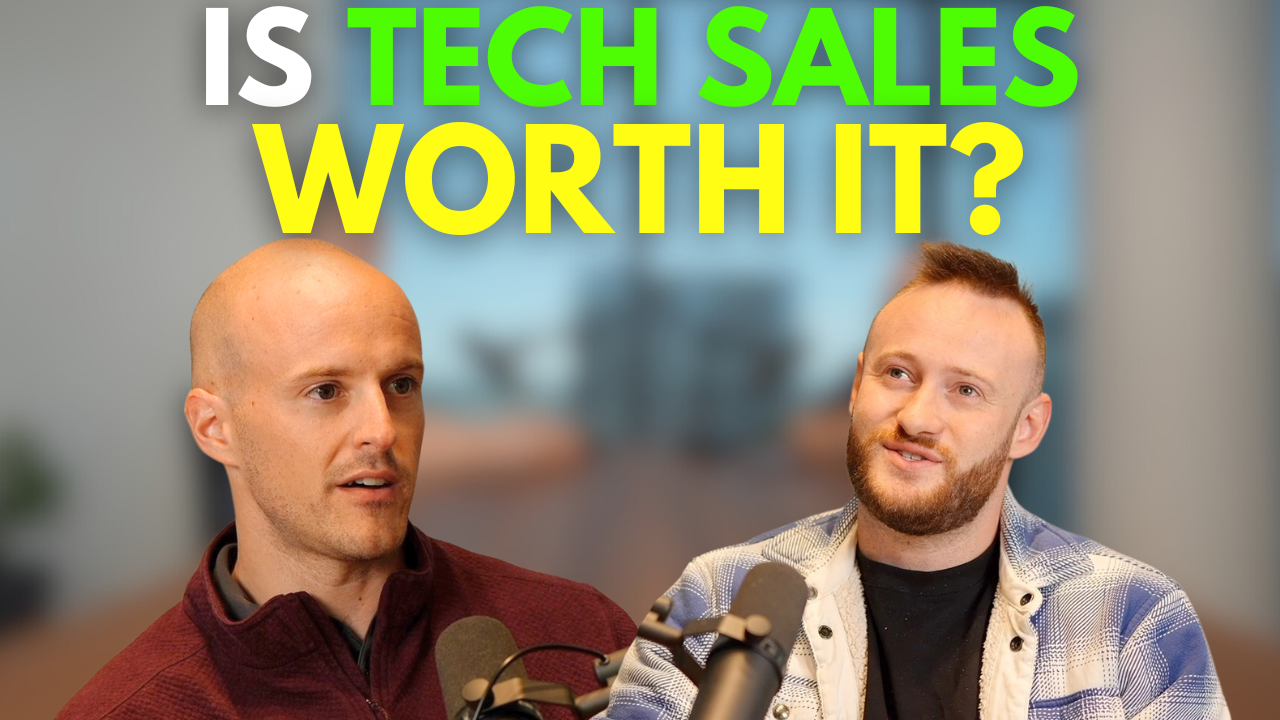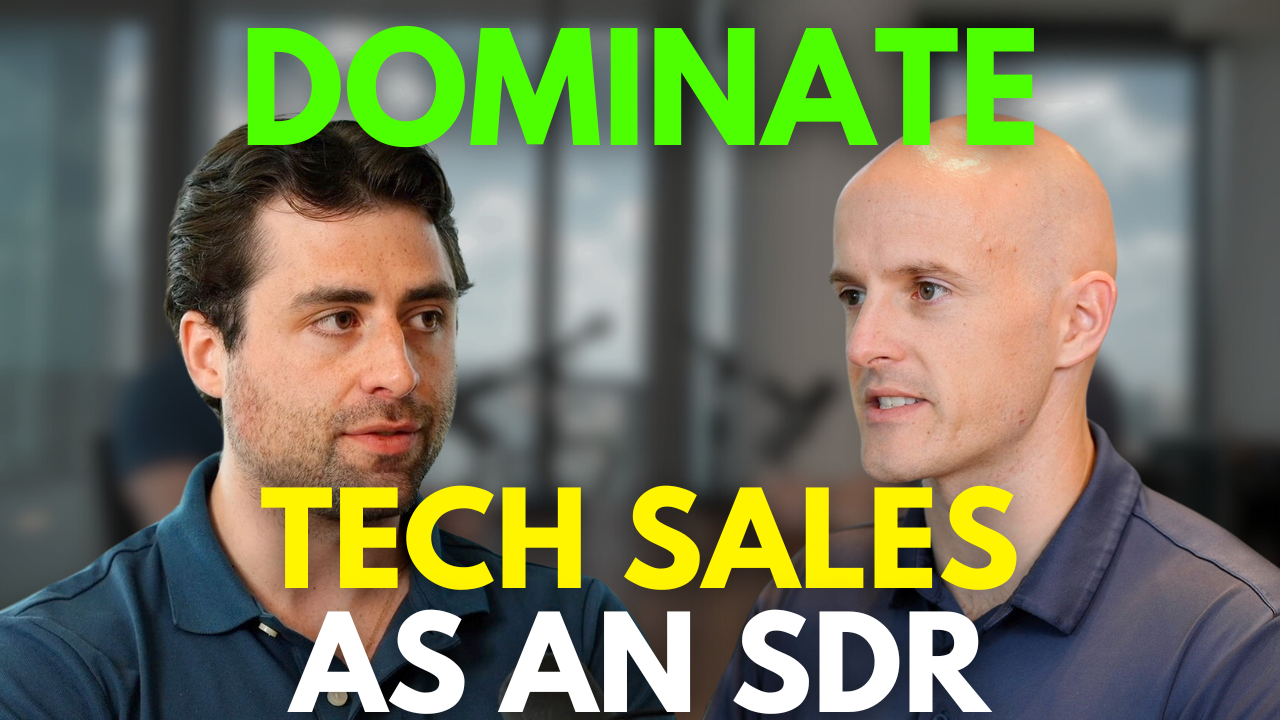The 90-Day SDR Ramp Plan: How to Hit Quota Faster in Tech Sales
A top Oracle SDR Manager outlines the 5-level "SDR Hierarchy of Needs," providing new and mid-level reps a direct, actionable 90-day plan focused on internal process, tool proficiency, and high-volume consistency to hit quota faster.
.png)

Most new SDRs and the managers who coach them get ramp-up all wrong. They take company training at face value and waste months on low-leverage activities. Sales is a competitive role, and the fastest way to crush your number is to be strategic from day one. This post lays out the 5-level SDR Hierarchy of Needs, a proven framework from Connor Murray, a multiple-time MVP and former #1 SDR Manager at Oracle, designed to help you bypass the fluff and hit quota faster. This is for any Aspiring SDR or Mid-level rep who needs a clear, actionable path to top-tier performance.
WHAT YOU’LL LEARN
- The non-negotiable first pillar of success that determines 50%+ of your quota attainment.
- The three basic tool proficiencies you must master to scale your outreach volume.
- Why most company-provided sales messaging is counterproductive—and what to use instead.
- The simple, repeatable "AB every other day" cadence to maximize cold call and email results.
- How to stop guessing and start using data to intelligently double down on what works.
CONTEXT: WHY THIS MATTERS
Sales is a volume-driven game, but quality volume is what matters. Many motivated SDRs, trying to work hard, fall into the trap of doing too much of the wrong thing—showing up early, staying late, yet seeing slow results. This happens because they lack a proven order of operations. They try to master complex messaging before mastering simple process, which creates massive internal friction. This is why you need a clear, step-by-step approach that prioritizes efficiency first.
"A lot of the training you’ll probably get will be useful, some won’t. I kind of want to just cut out the fluff and help people focus on what they actually need to know to ramp, because it’s not easy... it’s actually easier than a lot of people think."
LEVEL 1: INTERNAL ALIGNMENT (THE BASE PILLAR)
The first and most critical pillar, which can account for over 50% of your long-term success, is internal alignment with your Account Executive (AE) and organization.
The Belief: Your success is tied directly to the AE's willingness to invest in you and classify the meetings you set as qualified opportunities. You must earn their trust.
The Strategy: Earn Your Stripes An AE needs to see that the "juice is worth the squeeze." This means:
- Show up with a plan: Come to weekly 1:1s prepared, having executed on last week's plan, and demonstrate improvement week over week.
- Don't be a doormat: While you must earn their trust, you shouldn't let the AE box you out of your territory. Your job is developing long-term pipeline (3–4 quarters out), while theirs is focused on closed revenue (1–2 quarters out). It is your territory as much as theirs.
Actionable Tip: Control the Territory Conversation When meeting with your AE, do not ask, "What accounts should I go after?" This traps you into a reactive cycle. Instead, ask: “What accounts should I stay away from?” This assumes ownership of the entire territory and forces the AE to only limit you based on active deal cycles, not preference.
Key Reminder: Constantly remind your AEs how you get paid (meetings set, qualified opportunities, pipeline value). A lot of AEs, who are professional hires, don't know the SDR organization's metrics. This is how you win those 50/50 jump-ball opportunities.
LEVEL 2: TOOL PROFICIENCY AND INTERNAL SYSTEMS
Focusing on tools before cold calling ensures that when you do start outreach, you can scale it without friction. This level is about building proficiency in your CRM (Salesforce, HubSpot) and contact databases (ZoomInfo, SalesNav).
The Belief: If list-building and prospecting are a 4-hour process, you will never hit your numbers. Frictionless process is the key to volume.
The Three Capabilities You Must Master: Forget the bells and whistles. Ramping quickly means mastering these three basic activities:
- Filtering: The ability to filter prospects and leads by desired criteria (title, department, industry, geography) using a B2B database.
- List Building: The ability to add filtered prospects to a list with the click of a button, not a complex Excel export.
- Contacting: The ability to seamlessly contact prospects one-by-one via phone or email directly from your CRM/tools.
If you can do these three things easily, you can scale your prospecting. Get advice from tenured, successful SDRs on their list-building process—don't try to invent it all yourself.
LEVEL 3: DEVELOPING CONFIDENT TALK TRACKS AND MESSAGING
Once you have the process down, you can focus on the substance of your outreach. Most company-provided sales enablement is great for understanding the product's value proposition but terrible for creating effective sales messaging.
The Belief: Good sales messaging sounds natural, not "salesy" or like an internal product brief full of jargon (e.g., "single source of truth," "economic waste").
The Messaging Hierarchy (Build It Out Over Time): You must create multiple templates to ensure relevance. Start broad and get specific:
- General/Solution Level: A basic template for your solution.
- Department Specific: Messaging tailored to Finance, HR, Supply Chain, etc.
- Job Title Specific: Within Finance, messaging for FP&A (forward-looking planning) will differ from messaging for Controllers (closing the books/compliance).
- Industry Specific: Finance personas in banking vs. Finance personas in retail.
The Use Case Advantage: Prospects don't care about logos; they care about use cases. Get comfortable telling your top three customer stories (without naming the customer) that focus on a challenge the prospect is facing and how you solved it for someone else.
The Tip for Speed: In sales, plagiarism is encouraged. Find the top reps' working scripts and templates and start your iteration from there. The quickest way to ramp is over email—it requires the least initial skill and has guaranteed results at high volume. Cold calling is the higher-upside, more AI-proof skill to develop next.
LEVEL 4: THE SIMPLE, REPEATABLE OUTBOUND CADENCE
With great messaging and frictionless tools, the next step is a simple, repeatable process to execute at high volume. Avoid overly complex, multi-touch, 15-step cadences that are impossible to maintain at scale.
The Belief: The goal is to get relevant, value-based messaging into the hands of your target personas as frequently and consistently as possible. Simple works best.
The AB Every Other Day Cadence:
- Create Two Lists (A and B): List A could be VPs of FP&A, List B could be Controllers.
- Execution (Monday): Call List A, Email List B.
- Execution (Tuesday): Call List B, Email List A.
- Repeat: You are constantly touching two high-quality lists with different approaches every day.
Focus on Calls and Emails Only: Focus your energy on two channels you can scale. LinkedIn outreach complicates the process and can inadvertently hurt your response rate if the prospect sees your title and ignores your email later.
The Intensity Period: Use a concentrated, high-intensity cadence. Prefer about 7 touch points in a 7–10 day period. Response rates drop dramatically after 4 emails or 3 calls. After 10 days, move on to a fresh list. You can circle back to the original list after only 6–8 weeks, as prospects rarely remember prior outreach.
LEVEL 5: ITERATION AND CONSISTENCY (THE COMPOUND EFFECT)
Once the structure is in place, you gain the capacity to analyze performance, spot patterns, and double down on what works. This is where your results start to compound exponentially.
The Belief: You need a consistent process to intelligently track your progress. Without it, your results will be erratic and you won't know why you're winning or losing.
Spotting Patterns: Consistent, high-quality volume allows you to identify:
- Which persona/industry responds best to your current messaging.
- Key triggers (e.g., new leadership hires, recent acquisitions) that generate high-intent opportunities.
Stay Consistent, Build Your Internal Brand: Your results will never come in a straight line; you will have weeks that are hot and weeks that are cold. If managers see you consistently performing the right activities (making dials, sending emails, asking the right questions), you build internal brand equity. When a new territory opens up or a promotion becomes available, they will choose the SDR who shows up consistently and demonstrates long-term potential—even if they've had a few tough months on quota.
FAQ
Q: What’s the biggest mistake new SDRs make?
A: They over-rely on company training and jump to complex messaging (Level 3) before mastering their internal process and tools (Level 2), which limits their volume.
Q: How can I speed up the process of creating cold email templates?
A: Go directly to top-performing SDRs in your organization and ask to use their proven templates. Plagiarize what works, then iterate on it from there.
Q: How long should my outbound cadence be?
A: Focus on intensity over duration. Use a 7-touch, 7–10 day cadence (email/call every other day). Response rates drop dramatically after that, and you are better off moving to a fresh list.
→ Stop jumping from one unproven strategy to another. If you're ready to build a repeatable system that gets you promoted and helps you crush your number, check out the SDR to AE Accelerator program. We provide the full framework, proven templates, and live coaching to master every aspect of the SDR role, ramp faster than the competition, and promote to Account Executive.
TL;DR
- Level 1 (Alignment): Earn your AE's trust. Ask, "What accounts should I stay away from?" to own your territory.
- Level 2 (Tools): Master the 3 basics: Filter, List Build, Contact. Eliminate friction to enable high volume.
- Level 3 (Messaging): Prioritize natural-sounding scripts. Build templates from general to job-title specific.
- Level 4 (Cadence): Use the simple "AB every other day" structure to hit two lists consistently. Use a 7-touch, 7–10 day intense period.
- Level 5 (Iterate): Stay consistent. Use the process to spot patterns, double down on what works, and build your internal brand.
DATE LAST UPDATED
October 2025
.svg)
.svg)
.svg)
.svg)
.svg)
.svg)


.png)


.svg)








